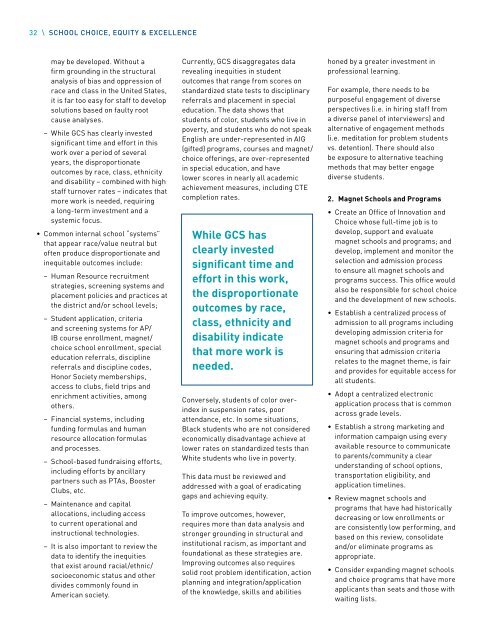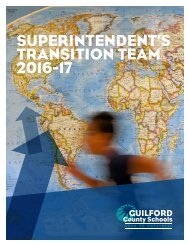Transition Team 2016-17 Final Report
Create successful ePaper yourself
Turn your PDF publications into a flip-book with our unique Google optimized e-Paper software.
32 \ SCHOOL CHOICE, EQUITY & EXCELLENCE<br />
may be developed. Without a<br />
firm grounding in the structural<br />
analysis of bias and oppression of<br />
race and class in the United States,<br />
it is far too easy for staff to develop<br />
solutions based on faulty root<br />
cause analyses.<br />
−−<br />
While GCS has clearly invested<br />
significant time and effort in this<br />
work over a period of several<br />
years, the disproportionate<br />
outcomes by race, class, ethnicity<br />
and disability – combined with high<br />
staff turnover rates – indicates that<br />
more work is needed, requiring<br />
a long-term investment and a<br />
systemic focus.<br />
• Common internal school “systems”<br />
that appear race/value neutral but<br />
often produce disproportionate and<br />
inequitable outcomes include:<br />
−−<br />
Human Resource recruitment<br />
strategies, screening systems and<br />
placement policies and practices at<br />
the district and/or school levels;<br />
−−<br />
Student application, criteria<br />
and screening systems for AP/<br />
IB course enrollment, magnet/<br />
choice school enrollment, special<br />
education referrals, discipline<br />
referrals and discipline codes,<br />
Honor Society memberships,<br />
access to clubs, field trips and<br />
enrichment activities, among<br />
others.<br />
−−<br />
Financial systems, including<br />
funding formulas and human<br />
resource allocation formulas<br />
and processes.<br />
−−<br />
School-based fundraising efforts,<br />
including efforts by ancillary<br />
partners such as PTAs, Booster<br />
Clubs, etc.<br />
−−<br />
Maintenance and capital<br />
allocations, including access<br />
to current operational and<br />
instructional technologies.<br />
−−<br />
It is also important to review the<br />
data to identify the inequities<br />
that exist around racial/ethnic/<br />
socioeconomic status and other<br />
divides commonly found in<br />
American society.<br />
Currently, GCS disaggregates data<br />
revealing inequities in student<br />
outcomes that range from scores on<br />
standardized state tests to disciplinary<br />
referrals and placement in special<br />
education. The data shows that<br />
students of color, students who live in<br />
poverty, and students who do not speak<br />
English are under-represented in AIG<br />
(gifted) programs, courses and magnet/<br />
choice offerings, are over-represented<br />
in special education, and have<br />
lower scores in nearly all academic<br />
achievement measures, including CTE<br />
completion rates.<br />
While GCS has<br />
clearly invested<br />
significant time and<br />
effort in this work,<br />
the disproportionate<br />
outcomes by race,<br />
class, ethnicity and<br />
disability indicate<br />
that more work is<br />
needed.<br />
Conversely, students of color overindex<br />
in suspension rates, poor<br />
attendance, etc. In some situations,<br />
Black students who are not considered<br />
economically disadvantage achieve at<br />
lower rates on standardized tests than<br />
White students who live in poverty.<br />
This data must be reviewed and<br />
addressed with a goal of eradicating<br />
gaps and achieving equity.<br />
To improve outcomes, however,<br />
requires more than data analysis and<br />
stronger grounding in structural and<br />
institutional racism, as important and<br />
foundational as these strategies are.<br />
Improving outcomes also requires<br />
solid root problem identification, action<br />
planning and integration/application<br />
of the knowledge, skills and abilities<br />
honed by a greater investment in<br />
professional learning.<br />
For example, there needs to be<br />
purposeful engagement of diverse<br />
perspectives (i.e. in hiring staff from<br />
a diverse panel of interviewers) and<br />
alternative of engagement methods<br />
(i.e. meditation for problem students<br />
vs. detention). There should also<br />
be exposure to alternative teaching<br />
methods that may better engage<br />
diverse students.<br />
2. Magnet Schools and Programs<br />
• Create an Office of Innovation and<br />
Choice whose full-time job is to<br />
develop, support and evaluate<br />
magnet schools and programs; and<br />
develop, implement and monitor the<br />
selection and admission process<br />
to ensure all magnet schools and<br />
programs success. This office would<br />
also be responsible for school choice<br />
and the development of new schools.<br />
• Establish a centralized process of<br />
admission to all programs including<br />
developing admission criteria for<br />
magnet schools and programs and<br />
ensuring that admission criteria<br />
relates to the magnet theme, is fair<br />
and provides for equitable access for<br />
all students.<br />
• Adopt a centralized electronic<br />
application process that is common<br />
across grade levels.<br />
• Establish a strong marketing and<br />
information campaign using every<br />
available resource to communicate<br />
to parents/community a clear<br />
understanding of school options,<br />
transportation eligibility, and<br />
application timelines.<br />
• Review magnet schools and<br />
programs that have had historically<br />
decreasing or low enrollments or<br />
are consistently low performing, and<br />
based on this review, consolidate<br />
and/or eliminate programs as<br />
appropriate.<br />
• Consider expanding magnet schools<br />
and choice programs that have more<br />
applicants than seats and those with<br />
waiting lists.



